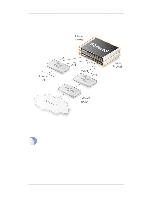D-Link DFL-260 Product Manual - Page 490
Unique Shared Mac Addresses, Cluster ID, Use Unique Share MAC, High Buffers, automatic
 |
UPC - 790069296802
View all D-Link DFL-260 manuals
Add to My Manuals
Save this manual to your list of manuals |
Page 490 highlights
11.3.4. Unique Shared Mac Addresses Chapter 11. High Availability • If this is not the first cluster in a network then the Cluster ID must be changed for the cluster so that it is unique (the default value is 0). The Cluster ID determines that the MAC address for the cluster is unique. • Enabling the advanced setting Use Unique Share MAC is recommended so that each interface has its own MAC address. If this is not enabled, interfaces share a MAC address and this can confuse some third party switches. • Make sure that the advanced setting High Buffers is set to be automatic for both units in the cluster. This setting determines how memory is allocated by NetDefendOS for handling increasing numbers of connections. A hardware restart is required for a change in this setting to take effect. Where a cluster has a very high number (for example, tens of thousands) of simultaneous connections then it may be necessary to set a high value for this instead of using automatic. A very high value for High Buffers can suit situations with large numbers of connections but can have the disadvantage of increasing throughput latency. 11.3.4. Unique Shared Mac Addresses For HA setup, NetDefendOS provides the advanced option Use Unique Shared MAC Address. By default, this is enabled and in most configurations it should not need to be disabled. Enabling a Unique Shared MAC Address The effect of enabling this setting is that a single, unique MAC address will be used for each pair of matching hardware interfaces so that, for example, the lan1 interface on the master unit will appear to have the same MAC address as the lan1 interface on the slave unit. Problem Diagnosis An HA cluster will function if this setting is disabled but can cause problems with a limited number of switch types where the switch uses a shared ARP table. Such problems can be hard to diagnose which is why it is best to always have the setting enabled. With Dissimilar Hardware Units In one situation, this setting should be disabled and that is when an HA cluster is set up using non-matching hardware. In order to function correctly, unique shared MAC addresses should not be used. 490















